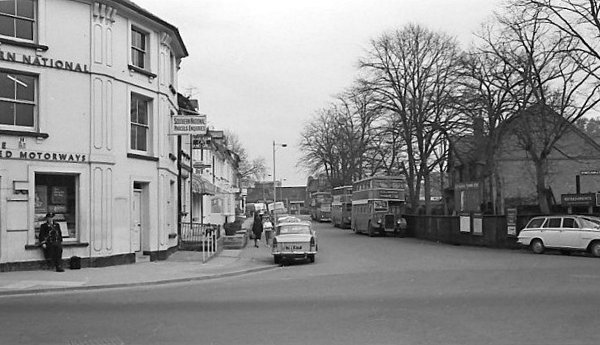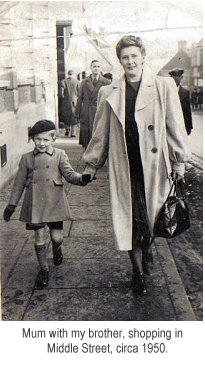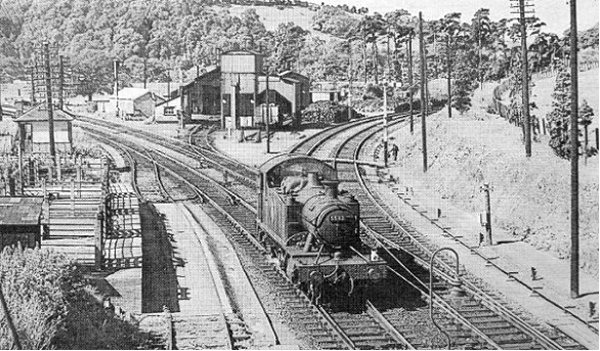A Shopping trip to yeovil
A shopping trip to yeovil
Shopping Trip to Yeovil in the 1950s
By Roger Froude
Today I walked up over Wyndham Hill and it reminded me of similar journey over sixty years ago. We lived in Yetminster, a village 5 miles south of Yeovil, and once a fortnight usually a Friday afternoon my older brother and I would have to come into Yeovil shopping with our Mum.
We would arrive at Pen Mill station early afternoon after catching the 1:30pm train from Yetminster. If it was in the winter or bad weather we would often cross to platform 2 and take what we called the “Push & Pull” to Yeovil Town Station. Alternately catch the green Southern National double decker bus waiting outside Pen Mill station. Also waiting outside would be a few taxis, Ron Dennett in his Morris Oxford, Tom Baker in a Ford Consul, Brian Hurly in his Standard Vanguard or Joe Shire in his Morris Oxford, but the thought of spending money on a taxis was completely out of the question.
Other times of the year, if the weather allowed, we would walk; up through the wicket gates to cross Sherborne Road and into Wyndham climbing the hill and watching railway engines being turned around on the turntable outside the engine sheds located in the V of the Weymouth and Taunton line just out of Pen Mill. After missing the cows, the cow pats, badger holes and ruts we arrived at the top and then the descent - usually running too fast with mother shouting “God help you if you fall over and break something”. But we survived, passing the air-raid shelter and out the swing gate across the road and down into Station Road where other excitement was found. The raised pavement - all children like walking along walls etc. and the high pavement was the attraction with it's constant up and downs for the steps to the properties, also mother shouting “Careful don’t you fall, now catch hold of my hand”.

Station Road seen from Middle Street in the early 1960s. Station Road was a convenient 'end of the line' bus stop close to the station and the offices of the Southern National bus company were housed in what had been the old temperance hotel, at left.
At the end was the National Bus offices, always with a lot of drivers and conductors waiting around outside and, of course, the busy traffic up and down Lower Middle Street. As you walked up towards the town you had the smell of the Gas Works and, on your left, the Gas Showrooms (now St Margaret’s Hospice charity shop). After the Liberal Club was Sellivents the florist shop and I believe Miss Murry was the florist then if not years later.
Towards the Triangle was the Co-op Outfitters, with the men's department as you walked in. There mum would buy our short grey school trousers (which always rubbed your bare legs), long grey school socks which you had elastic garters to keep them up, also the tri-coloured elastic belts to keep your trousers up with the “S” shaped silver buckle. Men in suits always served behind the counters, wrote out your purchases on the triple invoice pad then sending the top copy to the cashier who was housed in a cubicle the size of a telephone box with a glass window having a cut out to pass your money through (only cash in those days, credit/debit cards were unheard of and never even imagined). The invoice arrived to the cashier by whizzing in a container on a wire operated by the man at the counter which was the most thrilling part of the experience in the store for us boys.
Next stop or question from mum was “Do you boys need the toilet?” pointing to the toilets in the Triangle with it's white tiled walls and stone steps down to the Ladies or Gents and, of course, the penny you always needed if you required a cubical.

The Triangle, complete with the public toilets, photographed in the 1950s.
Going up through Middle Street the first stop was Halfords just up from what is now Poppin's on the left. In there mum was under instruction to purchase valve rubber for Granddad's bike tire valves or some carbide for his carbide lamp (years later we boys used carbide to put in someone’s desk inkwell at school - on leaving for morning or afternoon break and on return the ink would have froth all over the desk. As teenagers, near 5th November, if you put a piece of carbide in a cocoa tin with a hole in the bottom, spit on the carbide, closed the lid and put a lighted match by the hole - the explosion was better than any banger firework. The problem was locating the tin's lid afterwards because the tin went one way and the lid another. Halfords also sold toys which were at the rear of the shop, so that's where we always headed and always came out empty handed.
The next stop
was World Stores
(now Specsavers),
the 1950's
answer to
today’s
supermarket. The
aroma hit you as
you walked in as
it did in many
shops then. The
aroma of cooked
meats, fruits,
spices etc,
wooden floor
boards and the
occasional
pillar added to
the ambience.
There was no
self service,
you had to ask
for what you
wanted, such as
1lb (453g) of
sugar or 1lb of
soft fruit such
as currants, 1lb
of biscuits, and
so on. All these
items would be
weighed out by
the assistant
and put in blue
or brown paper
bag. A favourite
was a bag of
broken biscuits.
 As
we walked
further up
Middle Street,
mum would stop
at Mac Fisheries
where fresh fish
was displayed on
a slab outside
and occasionally
purchase kippers
or yellow
haddock. The
Arundel Ice
Cream Café was
always passed by
with the promise
of perhaps an
ice cream on the
way back down,
but that rarely
happened. We
would then cross
the road by The
George to
Woolworth's
which was like
entering Aladdin's
Cave for
children,
although it sold
everything for
children the
smell of roasted
peanuts, the
sweet counter
and of course
the toys were
the main
attraction.
Unfortunately
the counters
were always too
high for us
children to see
all the goods.
As
we walked
further up
Middle Street,
mum would stop
at Mac Fisheries
where fresh fish
was displayed on
a slab outside
and occasionally
purchase kippers
or yellow
haddock. The
Arundel Ice
Cream Café was
always passed by
with the promise
of perhaps an
ice cream on the
way back down,
but that rarely
happened. We
would then cross
the road by The
George to
Woolworth's
which was like
entering Aladdin's
Cave for
children,
although it sold
everything for
children the
smell of roasted
peanuts, the
sweet counter
and of course
the toys were
the main
attraction.
Unfortunately
the counters
were always too
high for us
children to see
all the goods.
Next door to
Woolly's was
Smith's with
newspapers,
comics and
magazines on
display on the
way in. Opposite
was the Penguin
book shop in the
corner between
Chubb's bakery
and Dunn's the
gentleman's
outfitters,
across Wine
Street and into
Marks and
Spencer’s where
mum would just
browse for a
while. Then we
would walk
through the bomb
site at the top
of Middle Street
(later Boots but
now Burger King)
- although a
bomb site, the
council had made
it attractive
with small
flower beds and
with the
occasional bench
to sit and rest.
At last the
Borough and the
aroma of ground
coffee beans
from Cadena
Café, a cup of
tea for mum and
a milk shake for
us boys if we
had behaved
ourselves.
This is where the shopping trip usually finished unless there was a specific reason to continue on up the High Street to visit Plummer's on the corner of King George Street, Moffat's, Gamis' or Denner's. Princes Street was very rare, but sometimes we would visit the Jolly Farmer Café on the corner of Park Road (now Prezzo).
On return to Middle Street, on the way back down to catch the 4:30pm train from Pen Mill, a visit to Frisby's shoe shop - where our feet were measured for a new pair of boots for school. Our plimsolls usually came from Woolly's (Woolworth's). Occasionally all traffic would come to a halt and pedestrians would stand clear as cattle was driven down through Middle Street from the market to the cattle pens at Pen Mill station to wait transporting on by train.
At the bottom of Lower Middle Street, at the junction of Central Road and Station Road, sometimes especially if it was raining we would catch the bus to Pen Mill waiting on the corner of Central Road. Just up the road was a wooden tea stall which, if I remember correctly, was painted green and usually there was a number of bus drivers or conductors taking refreshment. If we walked we knew it was a hair cut at Dike & Sons, the hairdressers in Sherborne Road.
 The
reason we went
there was
because dad was
brought up in
Southville and
went to school
with one of the
Dike's sons.
When it was our
turn a board was
placed across
the arms of the
well worn
leather chair and the
barber would say “the
usual today?”
which meant a
short back and
sides or
commonly know
then as a
“pudding basin
cut”. If
he
nicked your skin
while shaving
the back of your
neck with his
cut throat razor
he would apply
antiseptic stick
to the wound
which you feared
because it
always stung. On
finishing
Brylcreem would
be plastered on,
I was lucky with
curly hair as I
didn't have the
Brylcreem but I
still felt the
cold draught
around the back
of my neck when
we left.
The
reason we went
there was
because dad was
brought up in
Southville and
went to school
with one of the
Dike's sons.
When it was our
turn a board was
placed across
the arms of the
well worn
leather chair and the
barber would say “the
usual today?”
which meant a
short back and
sides or
commonly know
then as a
“pudding basin
cut”. If
he
nicked your skin
while shaving
the back of your
neck with his
cut throat razor
he would apply
antiseptic stick
to the wound
which you feared
because it
always stung. On
finishing
Brylcreem would
be plastered on,
I was lucky with
curly hair as I
didn't have the
Brylcreem but I
still felt the
cold draught
around the back
of my neck when
we left.
Arriving at the station, over the wooden footbridge passing the chocolate bar slot machine to platform 2 and waited for the train to take us home and on the way passing Grandfather's workshop just after the bridge next to the cattle pens - as he was the Chief Signal Engineer stationed at Pen Mill station.

Photo showing the cattle pens and my Grandfather's workshop, later my father's workshop.